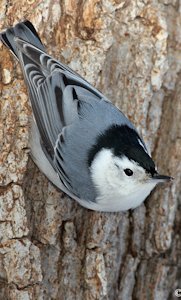
|
Birds Feeding on Insects Insect-eating species have developed specialized behaviors for finding insects in places such as leaf litter (towhees scratch with their feet), in soil (snipes probe with long bills), or in the air (swallows, swifts, and nighthawks perform high-speed aerial acrobatics). Of the species that spend time on tree trunks, White-breasted Nuthatch have developed a facility for walking down the trunk, with their heads toward the ground, while searching for insects in bark crevices. This may help them locate insects that would be missed by birds such as Brown Creepers that walk up tree trunks, with their heads tilted toward the sky. In fact, most of the special adaptations and feeding techniques we observe in birds have evolved to give a species access to foods that are overlooked by other, differently adapted species. The Dipper is a remarkable songbird with special adaptations to reach insects that are unavailable to other birds. This inhabitant of areas near streams in western North America actually dives and swims beneath the surface of fast-flowing streams, clinging to rocks with its feet to capture insect larvae from the stream bottom. Sapsuckers employ a fascinating variation of the tree-drilling techniques used by their woodpecker relatives. These birds drill a series of small, shallow holes, typically in rings around a tree trunk, to tap the sap that flows through the inner layers of bark. Each small hole is shaped to collect a tiny pool of sap. The bird then repeatedly flies to each hole in succession to imbibe. Insects are attracted to the sap holes, providing both meat and drink at a single sitting. |
| White-breasted Nuthatch |